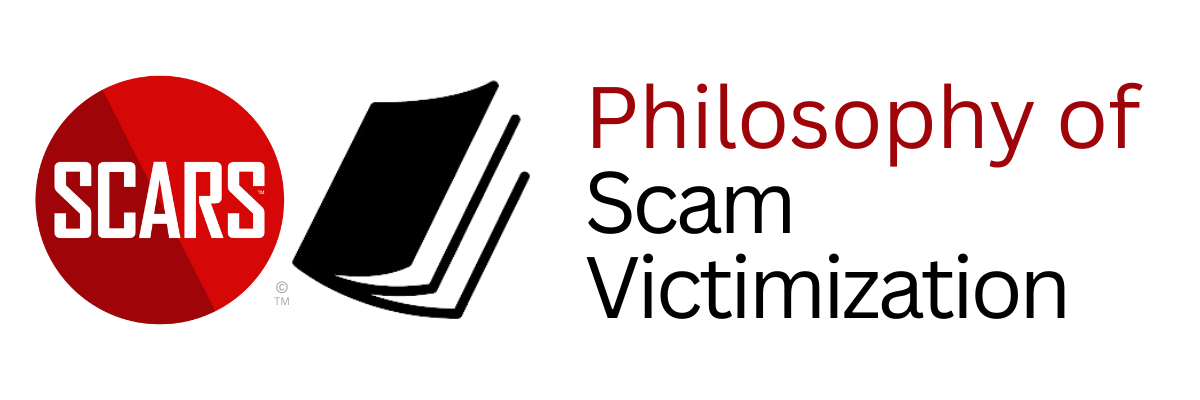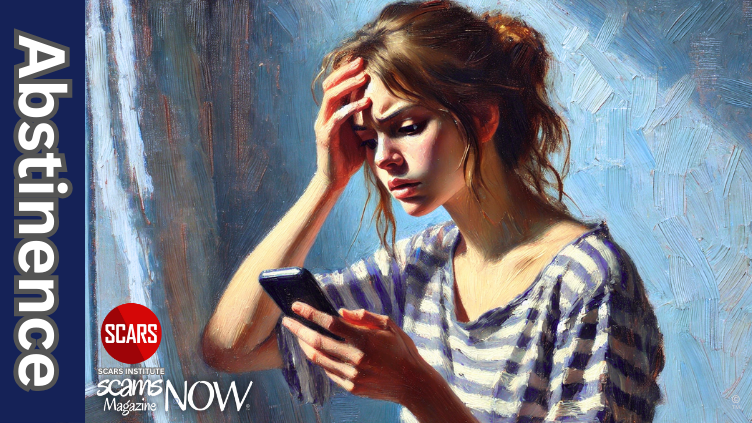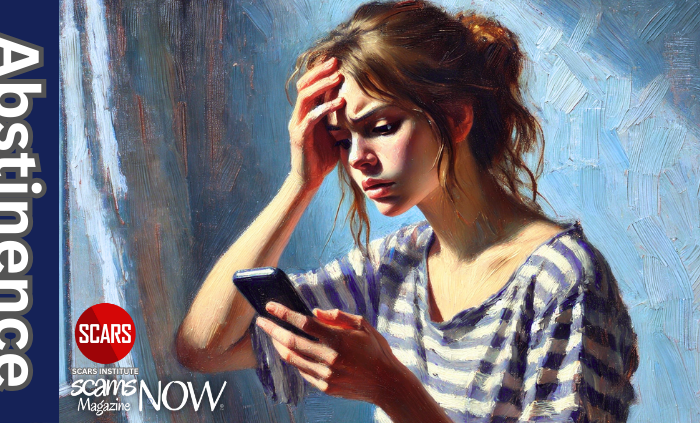Some Thoughts on the Nature of Evil and Scam Victims – Especially Betrayal as an Evil Act
A Taxonomy of Evil – Helping Scam Victims to Understand the Evil That Was Done to Them
Primary Category: Philosophy of Scams
Author:
• Tim McGuinness, Ph.D., DFin, MCPO, MAnth – Anthropologist, Scientist, Polymath, Director of the Society of Citizens Against Relationship Scams Inc.
About This Article
Evil is a very complex concept, with philosophical, psychological, and moral dimensions, and understanding it can help scam victims process the harm done to them.
This taxonomy of evil categorizes harmful actions based on intent and impact, such as intentional evil, where harm is deliberate, and instrumental evil, where harm is a byproduct of another goal, such as greed or desperation. It’s important to separate evil acts from inherently evil individuals—scammers often act out of financial need or pressure, not intrinsic malice. Understanding this distinction is important for justice, rehabilitation, and emotional recovery for victims.
The banality of evil, a concept by Hannah Arendt, highlights how ordinary people can commit harmful acts without fully grasping their moral weight, often due to systemic pressures or moral disengagement. By viewing evil in this broader context, we can better address both the actions and the circumstances that lead to such evil behavior.

A Taxonomy of Evil – Helping Scam Victims to Understand the Evil That Was Done to Them
1. Introduction to Evil
Evil is a complex concept, encompassing a range of harmful behaviors, intentions, and actions. Philosophers, theologians, and psychologists have long sought to classify and understand the nature of evil, leading to various frameworks. Below is a taxonomy of evil, categorizing different forms based on motivations, impacts, and types of harm inflicted:
It’s critical to distinguish between evil acts and evil people when considering actions like scams or other harmful behaviors. While certain actions—such as deceiving and exploiting others for personal gain—can be considered evil (and clearly are,) it doesn’t always mean the person committing them is inherently evil. Many individuals who engage in scamming may do so out of desperation, financial need and greed, or due to pressure from external factors, rather than because they are fundamentally malicious or malevolent.
The Complexity of Human Behavior
Human behavior is complex, and people are influenced by a variety of factors, including socioeconomic conditions, upbringing, culture, and personal circumstances. Scammers, for example, are often driven by greed, necessity, or the allure of quick financial gain, but so are most Wall Street traders. Some may not fully understand the impact of their actions or may rationalize them by dehumanizing their victims. This aligns with instrumental evil (see below,) where harm is done as a means to an end rather than out of pure malice. In such cases, the act is evil, but the individual may not be wholly evil; they are normal people making profoundly wrong choices.
Moral Blindness and Rationalization
In many instances, those who commit scams engage in moral disengagement—a psychological process where they distance themselves from the consequences of their actions. By rationalizing their behavior, they might not feel the full weight of the harm they cause, convincing themselves they are just “doing business” or “surviving.” This echoes Hannah Arendt’s concept of the banality of evil, where ordinary people commit harmful acts without truly grasping the moral implications, often by following orders or societal pressures. In such cases, the evil resides more in the acts than in the inherent nature of the individuals committing them.
Some People May Be Truly Evil
However, there are cases where individuals exhibit patterns of behavior that suggest deeper malignant traits, such as psychopathy or malignant narcissism, which drive them to exploit and harm others without remorse or empathy with intention. These individuals might commit evil acts not just for gain, but because they derive satisfaction from manipulating or hurting others. In such cases, the distinction between the act and the individual blurs, as their actions are driven by a deeper, more intrinsic malevolence.
Why This Distinction Matters to Scam Victims
Understanding the difference between an evil act and an evil person is important for several reasons:
Justice and Rehabilitation: It allows for more nuanced approaches to justice, where the focus can be on rehabilitating those who have made bad choices rather than condemning them as inherently bad people. Scammers, especially those driven by external pressures, may benefit from reform if given the right support and opportunity.
Victim Recovery: For victims of scams, recognizing that not all scammers are truly evil can aid in their emotional recovery. It can help them understand that they were targeted by individuals who, in many cases, may be trapped in their own challenging circumstances or who did not fully understand the harm they were doing.
Preventing Overgeneralization: Labeling entire groups of people as evil (such as all scammers) can lead to dangerous overgeneralizations and societal divisions. Instead, focusing on the actions rather than condemning the individual can promote empathy, dialogue, and solutions that address the root causes of such behavior. This is the model that the SCARS Institute uses in its work in West Africa.
While evil acts—like scams—should be completely condemned, like all violent crimes, it is important to recognize that many of the individuals committing them are not inherently evil. They are often driven by complex circumstances, making very poor decisions in a flawed system. By understanding this distinction, we can more effectively address both the act and the people behind it.
2. The Taxonomy of Evil
Intentional Evil
Definition: Actions that are deliberately performed with the intent to cause harm.
Examples: Murder, torture, terrorism, sadistic violence.
Key Characteristics: Intention is central. The person is fully aware that their actions will cause suffering or destruction and proceeds with that understanding.
Philosophical View: Traditionally seen as moral evil. Many philosophers, including Immanuel Kant, have discussed the concept of willful malevolence—choosing to act against moral law despite knowing better.
Instrumental Evil
Definition: Harmful actions carried out as a means to an end, where the harm is not the primary objective but is accepted as a consequence.
Examples: Exploiting workers for profit, unethical scientific experiments, war crimes.
Key Characteristics: The harm is rationalized as necessary or unavoidable to achieve a larger goal.
Philosophical View: Utilitarian justifications are often cited in instrumental evil, where the ends are argued to justify the means, even if harm is caused along the way.
Ideological Evil
Definition: Evil motivated by a belief system or ideology that justifies harm to others, often on a large scale.
Examples: Genocide, religious persecution, slavery.
Key Characteristics: Actions are justified based on a perceived moral or ideological duty. The perpetrators believe they are serving a higher cause.
Philosophical View: This is often tied to collective evil, where systemic structures (such as totalitarian regimes) perpetuate atrocities for the “greater good” of the ideology.
Malignant Narcissism
Definition: A combination of narcissism, aggression, and the desire to dominate, resulting in the dehumanization and exploitation of others.
Examples: Dictatorship, manipulation in relationships, abuse of power.
Key Characteristics: Personal aggrandizement and power come at the expense of others, often involving cruelty and a lack of empathy.
Psychological View: Sigmund Freud and later psychoanalysts have linked this type of evil to extreme forms of narcissistic personality disorder, where self-centeredness leads to destructive behavior.
Banal Evil
Definition: Evil committed by ordinary people who conform to orders or norms without questioning the morality of their actions.
Examples: Participation in atrocities under dictatorial regimes, corporate malfeasance, systemic racism.
Key Characteristics: Individuals may not see themselves as evil and may claim they are simply following orders or societal norms.
Philosophical View: Hannah Arendt’s concept of the “banality of evil” suggests that evil can arise from ordinary people performing bureaucratic tasks without questioning the broader implications of their actions.
Reactive Evil
Definition: Evil born out of a response to perceived harm or injustice, often driven by vengeance or hatred.
Examples: Retaliatory violence, acts of terror following oppression, personal vendettas.
Key Characteristics: While the individual may see themselves as reacting to a wrong done to them, the response is disproportionate and intentionally harmful.
Philosophical View: Closely tied to Nietzschean views of ressentiment, where perceived inferiority or victimhood leads to destructive actions against perceived oppressors.
Psychological/Pathological Evil
Definition: Evil rooted in mental illness or severe psychological disturbances.
Examples: Serial killers, psychopathic behavior, extreme sadism.
Key Characteristics: Lack of empathy, remorse, or moral reasoning; enjoyment of inflicting pain.
Psychological View: Tied to conditions like psychopathy or antisocial personality disorder, where individuals lack the emotional capacity to understand or care about the harm they cause.
Accidental/Unintentional Evil
Definition: Harm caused without malicious intent, often as a result of negligence or ignorance.
Examples: Neglecting safety protocols leading to fatalities, unintended environmental destruction.
Key Characteristics: No direct intent to harm, but consequences are still damaging, often due to indifference or a lack of forethought.
Moral View: Philosophers like John Stuart Mill might classify this under the broader umbrella of harm, regardless of intent, focusing instead on the consequences.
Systemic Evil
Definition: Harm caused by established systems or structures within society that perpetuate inequality, exploitation, or oppression.
Examples: Racism, sexism, economic inequality, environmental degradation by corporations.
Key Characteristics: No single individual is directly responsible; rather, the evil is embedded in societal systems that benefit certain groups at the expense of others.
Sociological View: Systemic evil aligns with institutional critique, such as that seen in Marxism, which focuses on how capitalist or hierarchical systems generate widespread harm.
Conclusion
This taxonomy of evil demonstrates that “evil” is not a one-size-fits-all concept. It varies based on intent, awareness, and context. From deliberate malevolence to the banality of evil, and from systemic injustices to pathological cruelty, the concept of evil encompasses a wide spectrum of human behaviors and societal structures. Understanding these categories helps us comprehend the complexity behind harmful actions and provides insights into how we might combat them, both as individuals and as societies.
3. Philosophy of Evil
What Most Philosophers Thought of Evil
The taxonomy of evil I provided draws from various philosophical, psychological, and sociological sources. It reflects ideas from thinkers such as:
Immanuel Kant: Kant’s moral philosophy, especially his focus on intentional evil, where evil is defined by an individual’s will to act against moral law.
Hannah Arendt: In her work Eichmann in Jerusalem, she coined the term “banality of evil,” which suggests that ordinary people can commit evil acts without necessarily being malevolent, simply by conforming to orders and societal norms. (see more below)
Friedrich Nietzsche: His concept of ressentiment, particularly the reactive or revenge-driven evil, where individuals, feeling powerless or victimized, react destructively to those they perceive as oppressors.
Sigmund Freud: Freud’s exploration of malignant narcissism as a driver of evil behaviors, where individuals act with cruelty and domination as a result of psychological disorders or extreme narcissism.
John Stuart Mill: His focus on the consequences of actions (consequentialism), particularly the idea that evil can be done unintentionally if it causes harm, regardless of intent.
Marxist and Sociological Critiques: Systemic or institutional evil often derives from analyses of power structures and inequality, particularly from Marxist theory and critiques of capitalism, which argue that societal systems can generate widespread harm without the direct intent of individuals.
This taxonomy combines ideas from moral philosophy, psychology, and social theory, providing a broader understanding of how evil manifests in various forms.
The Philosophy of Evil
The philosophy of evil grapples with one of the most profound and disturbing aspects of human existence: the capacity for immense harm, cruelty, and malevolence. Philosophers throughout history have sought to understand what constitutes evil, why it exists, and how it should be addressed. Fundamentally, discussions about evil explore not only the nature of destructive actions but also the moral character of individuals and societies that permit or perpetrate them.
Evil is typically categorized in two primary forms: natural evil and moral evil. Natural evil refers to suffering caused by events outside human control, such as natural disasters or diseases. Moral evil, on the other hand, is the result of human actions or decisions that intentionally or unintentionally cause harm. It is within the realm of moral evil that much of the philosophical debate focuses, examining the motivations behind harmful actions and the ethical consequences of such behavior.
The Problem of Evil
One of the central issues in the philosophy of evil is the problem of evil, especially as it relates to theology. This concept challenges the coexistence of an omnipotent, omniscient, and benevolent God with the presence of evil in the world. Thinkers like Epicurus and David Hume have asked, if God is both all-powerful and wholly good, why does evil exist? This conundrum has prompted many theological and philosophical responses, from the idea of free will (as proposed by St. Augustine) to the concept that evil may be necessary for moral growth or to allow for human freedom.
Evil as Intentional Harm
Philosophers such as Immanuel Kant emphasized the intentional aspect of evil, focusing on the moral will of individuals. According to Kant, actions are deemed evil when they are driven by a will that knowingly chooses to act against moral law. In this view, evil is a deliberate choice, an act of defiance against the ethical principles that guide moral behavior.
Hannah Arendt’s “Banality of Evil”
In modern philosophy, Hannah Arendt introduced the concept of the “banality of evil”, which emerged from her observations of Adolf Eichmann during his trial for crimes committed during the Holocaust. Arendt suggested that evil does not always manifest as monstrous acts committed by obviously malevolent individuals. Instead, it can be carried out by ordinary people who fail to think critically about the consequences of their actions, thus committing horrific acts in the name of conformity or duty. This reframing of evil challenged the conventional image of evildoers as inherently corrupt, instead proposing that evil can stem from a lack of reflection or moral disengagement.
Evil as Part of Human Nature
Some philosophers, like Thomas Hobbes, viewed evil as an integral part of human nature. Hobbes believed that humans are inherently selfish and driven by a desire for power, and that without the structure of society and law, this would lead to chaos and harm. Conversely, thinkers like Jean-Jacques Rousseau argued that humans are naturally good, and that evil arises due to the corrupting influences of society and institutions.
The philosophy of evil encompasses a wide range of perspectives, from theological dilemmas about the existence of evil to psychological and sociological explorations of what drives individuals to commit harmful acts. It questions the nature of human morality and offers frameworks for understanding how and why evil manifests in the world. This ongoing debate continues to shape how we view justice, punishment, and moral responsibility in the face of human suffering and wrongdoing.
Integrating the Philosophy of Evil with the Taxonomy of Evil
The philosophy of evil provides the conceptual foundation for understanding the motivations, nature, and moral dimensions of evil actions, while the taxonomy of evil offers a structured framework to categorize different types of evil based on intent, impact, and societal influence. Together, they help us see evil both as a philosophical problem and as a practical reality that manifests in various forms.
Intentional Evil and Kant’s Moral Philosophy
Immanuel Kant’s philosophy, which emphasizes the role of will and intention in moral actions, aligns directly with the category of intentional evil in the taxonomy. Kant’s notion that evil arises when individuals deliberately choose to act against moral law integrates smoothly with the taxonomy’s classification of actions that are done with full awareness of their harmful consequences. This shows how Kant’s focus on moral responsibility fits within the structured understanding of deliberate, malicious acts.
The Banality of Evil and Systemic Evil
Hannah Arendt’s concept of the banality of evil—where ordinary people commit atrocities without deep malice, often through thoughtlessness or conformity—integrates into both banal evil and systemic evil in the taxonomy. Her work illustrates how large-scale harm can occur when people fail to critically examine their actions, resonating with the idea that systemic evil arises from participation in corrupt structures. The taxonomy categorizes these forms of evil as more institutional or bureaucratic, where individuals might not recognize their actions as part of a larger, destructive system.
Hobbes and Psychological Evil
Thomas Hobbes’ belief that humans are naturally selfish and prone to violence without societal constraints can be linked to psychological/psychopathic evil in the taxonomy. This reflects how innate human tendencies, unchecked by law or morality, can lead to acts of cruelty. Hobbes’ philosophical stance finds a home in the taxonomy where evil actions arise from innate or deeply embedded psychological tendencies, especially those rooted in self-interest or power dynamics.
Rousseau and Unintentional Evil
Conversely, Jean-Jacques Rousseau’s argument that society corrupts naturally good people aligns with the taxonomy’s category of unintentional evil. Rousseau believed that human beings become corrupted by societal influences, which can lead to harmful actions that may not be intended as evil but arise due to environmental factors. In the taxonomy, this fits with actions that cause harm out of ignorance or misguided intentions, showing how the external world can lead individuals to commit harmful acts without explicit malice.
The Problem of Evil and Systemic/Collective Evil
The theological problem of evil, especially its exploration in religious contexts, can also intersect with systemic evil in the taxonomy. The existence of widespread harm in the world, often perpetuated by institutions or regimes, can be viewed as a manifestation of collective evil. Philosophers exploring theodicy—how evil exists in a world governed by a benevolent God—often point to the structural and collective nature of evil as something beyond individual control, resonating with the taxonomy’s focus on institutionalized harm.
The philosophy of evil provides the theoretical foundation for understanding the moral questions behind why evil exists, while the taxonomy of evil classifies specific manifestations of evil in everyday actions and systems. Together, they offer a comprehensive lens through which we can examine both the motivations behind harmful behavior and the diverse forms in which evil can appear in the world. Integrating both frameworks enhances our understanding of human morality and the complexities behind acts of harm and cruelty.
Burton, Milton, and Dante’s Views of Evil
Robert Burton’s View (The Anatomy of Melancholy):
Burton’s focus on human behavior, particularly in terms of mental affliction and melancholy, aligns with the psychological and pathological aspects of evil in the taxonomy. He explores how mental disturbances and societal pressures can lead individuals toward destructive actions, often without clear intent. Burton’s emphasis on human frailty and how emotional instability can drive poor decisions connects with the idea of psychological evil—where external and internal factors (such as sadness or melancholy) can warp an individual’s behavior into something harmful. In his view, evil actions might arise from uncontrolled emotions or despair, which resonate with the unintentional or reactionary forms of evil.
John Milton’s View (Paradise Lost):
Milton’s portrayal of Satan in Paradise Lost explores several layers of evil, particularly intentional, ideological, and narcissistic evil. Satan’s rebellion against God is motivated by pride, ambition, and resentment, which mirrors Nietzsche’s concept of ressentiment. Satan is the embodiment of intentional evil, as his rebellion is a conscious choice to defy the moral order. His efforts to corrupt humanity also represent ideological evil, as Satan believes in his own righteousness and justifies his actions with a twisted belief system. Milton’s Satan could also be seen as an example of malignant narcissism, as his quest for power leads him to manipulate and harm others without remorse, highlighting personal aggrandizement.
Dante Alighieri’s View (Inferno and Divine Comedy)
Dante’s Inferno provides a detailed hierarchy of evil, where each sin is carefully categorized based on its severity and intent. His depiction fits closely with intentional and ideological evil as well. The lower circles of Hell, reserved for fraud and treachery, are closely aligned with intentional evil, where individuals deliberately betray others for personal gain. Dante’s gradation of sins also reflects instrumental evil: many of the condemned acted out of ambition, greed, or revenge, accepting the harm caused as part of their pursuit of personal goals. Furthermore, Dante’s depiction of various historical and mythological figures who rationalized their actions under misguided beliefs can be interpreted as ideological evil—where evil is justified under a perverse worldview.
Integrating Their Views with the Taxonomy
-
- Burton: His view fits well with psychological evil and unintentional evil, where individuals act out of mental frailty or emotional disturbance rather than malicious intent.
- Milton: Milton’s Satan represents intentional, narcissistic, and ideological evil, particularly as Satan is driven by self-interest and defiance of divine authority.
- Dante: Dante’s structured vision of Hell mirrors intentional, instrumental, and ideological evil, particularly in the way sinners are punished based on the depth of their willful actions and justifications.
Each author reflects on evil through different lenses—psychological complexity (Burton), grand moral conflict (Milton), and divine justice (Dante)—but all contribute to a richer understanding of how evil manifests in human behavior.
Dante’s Inferno and Betrayal Evil
In Dante’s Inferno, betrayal is placed in the Ninth Circle of Hell, reserved for the worst of sinners. This circle represents treachery—a deliberate, calculated betrayal of trust, especially against close relationships like family, country, or benefactors. Dante views betrayal as the ultimate evil, symbolized by Satan himself, eternally trapped in ice, who betrayed God by rebelling against divine authority.
In terms of the taxonomy of evil, betrayal fits squarely within intentional evil and ideological evil:
Intentional Evil
Betrayal is a deliberate act, often premeditated, where an individual knowingly harms another by breaking trust. Those who commit betrayal do so with full knowledge of the damage they cause, aligning this sin with the core of intentional evil. The calculated nature of betrayal, especially in Dante’s hierarchy, represents the worst kind of willful harm, where personal gain or spite is prioritized over moral duty or relationships.
Ideological Evil
Betrayal can also involve an element of ideological evil, particularly when the betrayal is justified by the individual’s worldview. Satan, for instance, in his rebellion against God, might rationalize his betrayal as a quest for power or freedom, believing in his own distorted ideology. Similarly, in Dante’s Ninth Circle, betrayers may have justified their actions within their own frameworks of power, greed, or ambition, believing their goals are worth the treachery.
Satan’s Betrayal in Dante
Satan’s betrayal of God is the archetype of ultimate intentional evil—it was an act of cosmic treachery, knowingly defying the highest moral authority for selfish reasons. His eternal punishment in ice reflects the coldness and calculated nature of betrayal, as well as its isolating and destructive consequences.
Instrumental Evil
There is also a case for instrumental evil in Dante’s Ninth Circle. Betrayal often serves a selfish purpose, such as gaining power, wealth, or revenge. In this sense, the betrayal isn’t necessarily done out of pure malice but as a means to an end. However, the end is so deeply immoral that it reinforces the depth of the evil involved.
Thus, Dante’s placement of betrayal as the worst sin aligns with the highest form of intentional and ideological evil, where trust is violated for personal gain, causing profound harm to the very fabric of human relationships and moral order.
-/ 30 /-
What do you think about this?
Please share your thoughts in a comment below!
A Note About Labeling!
We often use the term ‘scam victim’ in our articles, but this is a convenience to help those searching for information in search engines like Google. It is just a convenience and has no deeper meaning. If you have come through such an experience, YOU are a Survivor! It was not your fault. You are not alone! Axios!
-/ 30 /-
What do you think about this?
Please share your thoughts in a comment below!
One Comment
Leave A Comment
Important Information for New Scam Victims
- Please visit www.ScamVictimsSupport.org – a SCARS Website for New Scam Victims & Sextortion Victims.
- SCARS Institute now offers its free, safe, and private Scam Survivor’s Support Community at www.SCARScommunity.org – this is not on a social media platform, it is our own safe & secure platform created by the SCARS Institute especially for scam victims & survivors.
- SCARS Institute now offers a free recovery learning program at www.SCARSeducation.org.
- Please visit www.ScamPsychology.org – to more fully understand the psychological concepts involved in scams and scam victim recovery.
If you are looking for local trauma counselors, please visit counseling.AgainstScams.org
If you need to speak with someone now, you can dial 988 or find phone numbers for crisis hotlines all around the world here: www.opencounseling.com/suicide-hotlines
Statement About Victim Blaming
Some of our articles discuss various aspects of victims. This is both about better understanding victims (the science of victimology) and their behaviors and psychology. This helps us to educate victims/survivors about why these crimes happened and not to blame themselves, better develop recovery programs, and help victims avoid scams in the future. At times, this may sound like blaming the victim, but it does not blame scam victims; we are simply explaining the hows and whys of the experience victims have.
These articles, about the Psychology of Scams or Victim Psychology – meaning that all humans have psychological or cognitive characteristics in common that can either be exploited or work against us – help us all to understand the unique challenges victims face before, during, and after scams, fraud, or cybercrimes. These sometimes talk about some of the vulnerabilities the scammers exploit. Victims rarely have control of them or are even aware of them, until something like a scam happens, and then they can learn how their mind works and how to overcome these mechanisms.
Articles like these help victims and others understand these processes and how to help prevent them from being exploited again or to help them recover more easily by understanding their post-scam behaviors. Learn more about the Psychology of Scams at www.ScamPsychology.org
SCARS INSTITUTE RESOURCES:
If You Have Been Victimized By A Scam Or Cybercrime
♦ If you are a victim of scams, go to www.ScamVictimsSupport.org for real knowledge and help
♦ SCARS Institute now offers its free, safe, and private Scam Survivor’s Support Community at www.SCARScommunity.org/register – this is not on a social media platform, it is our own safe & secure platform created by the SCARS Institute especially for scam victims & survivors.
♦ Enroll in SCARS Scam Survivor’s School now at www.SCARSeducation.org
♦ To report criminals, visit https://reporting.AgainstScams.org – we will NEVER give your data to money recovery companies like some do!
♦ Follow us and find our podcasts, webinars, and helpful videos on YouTube: https://www.youtube.com/@RomancescamsNowcom
♦ Learn about the Psychology of Scams at www.ScamPsychology.org
♦ Dig deeper into the reality of scams, fraud, and cybercrime at www.ScamsNOW.com and www.RomanceScamsNOW.com
♦ Scam Survivor’s Stories: www.ScamSurvivorStories.org
♦ For Scam Victim Advocates visit www.ScamVictimsAdvocates.org
♦ See more scammer photos on www.ScammerPhotos.com
You can also find the SCARS Institute’s knowledge and information on Facebook, Instagram, X, LinkedIn, and TruthSocial
Psychology Disclaimer:
All articles about psychology and the human brain on this website are for information & education only
The information provided in this and other SCARS articles are intended for educational and self-help purposes only and should not be construed as a substitute for professional therapy or counseling.
Note about Mindfulness: Mindfulness practices have the potential to create psychological distress for some individuals. Please consult a mental health professional or experienced meditation instructor for guidance should you encounter difficulties.
While any self-help techniques outlined herein may be beneficial for scam victims seeking to recover from their experience and move towards recovery, it is important to consult with a qualified mental health professional before initiating any course of action. Each individual’s experience and needs are unique, and what works for one person may not be suitable for another.
Additionally, any approach may not be appropriate for individuals with certain pre-existing mental health conditions or trauma histories. It is advisable to seek guidance from a licensed therapist or counselor who can provide personalized support, guidance, and treatment tailored to your specific needs.
If you are experiencing significant distress or emotional difficulties related to a scam or other traumatic event, please consult your doctor or mental health provider for appropriate care and support.
Also read our SCARS Institute Statement about Professional Care for Scam Victims – click here
If you are in crisis, feeling desperate, or in despair, please call 988 or your local crisis hotline – international numbers here.
More ScamsNOW.com Articles
A Question of Trust
At the SCARS Institute, we invite you to do your own research on the topics we speak about and publish. Our team investigates the subject being discussed, especially when it comes to understanding the scam victims-survivors’ experience. You can do Google searches, but in many cases, you will have to wade through scientific papers and studies. However, remember that biases and perspectives matter and influence the outcome. Regardless, we encourage you to explore these topics as thoroughly as you can for your own awareness.















![NavyLogo@4x-81[1] Some Thoughts on the Nature of Evil and Scam Victims - Especially Betrayal as an Evil Act - 2024](https://scamsnow.com/wp-content/uploads/2025/04/NavyLogo@4x-811.png)









![scars-institute[1] Some Thoughts on the Nature of Evil and Scam Victims - Especially Betrayal as an Evil Act - 2024](https://scamsnow.com/wp-content/uploads/2025/04/scars-institute1.png)

![niprc1.png1_-150×1501-1[1] Some Thoughts on the Nature of Evil and Scam Victims - Especially Betrayal as an Evil Act - 2024](https://scamsnow.com/wp-content/uploads/2025/04/niprc1.png1_-150x1501-11.webp)

As scam victims, we need to realize that harm was done to us but in most of the cases the criminal did not weigh the consequences of their acts and it was not personal. They could be scammers for greed, as a means to earn their pay, as a means to survive (as in the huge buildings where people are kept captive and forced to scam others), or for other reasons that could make them go into the instrumental or ideological evil categories. In any case, they did not target us personally, and understanding this can help us move forward after the scam. Moreover, by knowing this we can be more cautious in the online world as scammers could have various backgrounds and intentions.
SSTES ENH